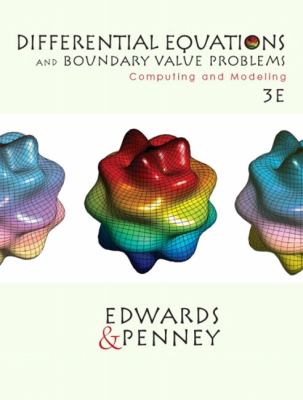145279
9780130652454
Differential Equations and Boundary Valve Problems Computing and Modeling
by Edwards, C. Henry, Penney, David E.
About this item
- Condition: New
- Provider: gridfreed
- Provider Rating: 68%
- Ships From: San Diego, CA
- Shipping: Standard
- Comments: New. In shrink wrap. Looks like an interesting title!

About this item
- Condition: Acceptable
- Provider: BooksRun
- Provider Rating: 95%
- Ships From: Philadelphia, PA
- Shipping: Standard, Expedited
- Comments: Ship within 24hrs. Satisfaction 100% guaranteed. APO/FPO addresses supported

Product details
- ISBN-13: 9780130652454
- ISBN: 0130652458
- Edition: 3
- Publication Date: 2003
- Publisher: Prentice Hall PTR
AUTHOR
SUMMARY
Many introductory differential equations courses in the recent past have emphasized the formal solution of standard types of differential equations using a (seeming) grab-bag of systematic solution techniques. Many students have concentrated on learning to match memorized methods with memorized equations. The evolution of the present text is based on experience teaching a course with a greater emphasis on conceptual ideas and the use of applications and computing projects to involve students in more intense and sustained problem-solving experiences. The availability of technical computing environments likeMaple, Mathematica,and MATLAB is reshaping the role and applications of differential equations in science and engineering and has shaped our approach in this text. New technology motivates a shift in emphasis from traditional manual methods to both qualitative and computer-based methods that render accessible a wider range of more realistic applications; permit the use of both numerical computation and graphical visualization to develop greater conceptual understanding; and encourage empirical investigations that involve deeper thought and analysis than standard textbook problems. Major Features The following features of this text are intended to support a contemporary differential equations course that augments traditional core skills with conceptual perspectives that students will need for the effective use of differential equations in their subsequent work and study: Coverage of seldom-used topics has been trimmed and new topics added to place a greater emphasis on core techniques as well as qualitative aspects of the subject associated with direction fields, solution curves, phase plane portraits, and dynamical systems. We combine symbolic, graphic, and numeric solution methods wherever it seems advantageous. A fresh computational flavor should be evident in figures, examples, problems, and applications throughout the text. About 15% of the examples in the text are new or newly revised for this edition. The organization of the book places an increased emphasis on linear systems of differential equations, which are covered in Chapters 4 and 5 (together with the necessary linear algebra), followed by a substantial treatment in Chapter 6 of nonlinear systems and phenomena (including chaos in dynamical systems). This book begins and ends with discussions and examples of the mathematical modeling of real-world phenomena. Students learn through mathematical modeling and empirical investigation to balance the questions of what equation to formulate, how to solve it, and whether a solution will yield useful information.,/LI> The first course in differential equations should also be a window on the world of mathematics. While it is neither feasible nor desirable to include proofs of the fundamental existence and uniqueness theorems along the way in an elementary course, students need to see precise and clear-cut statements of these theorems and to understand their role in the subject. We include appropriate existence and uniqueness proofs in the Appendix and occasionally refer to them in the main body of the text. While our approach reflects the widespread use of new computer methods for the solution of differential equations, certain elementary analytical methods of solution (as in Chapters 1 and 3) are important for students to learn. Effective and reliable use of numerical methods often requires preliminary analysis using standard elementary techniques; the construction of a realistic numerical model often is based on the study of a simpler analytical model. We therefore continue to stress the mastery of traditional solution techniques (especially through the inclusion of extensive problem sets). Computing Features The following features highlight the flavor of computing technology that distinguishes much ofEdwards, C. Henry is the author of 'Differential Equations and Boundary Valve Problems Computing and Modeling', published 2003 under ISBN 9780130652454 and ISBN 0130652458.
[read more]


